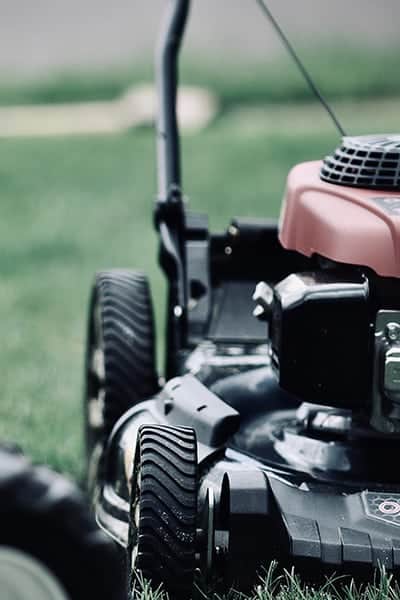Top Reasons Your Lawn Mower Won’t Start
I actually quite enjoy mowing the lawn, especially when it’s a beautiful Saturday afternoon. It’s usually a pretty painless chore however, there are times that things don’t go as expected. I’m sure I am not alone in the instant worry when your lawnmower won’t start! It can be very expensive to purchase a new lawnmower or to get it fixed by someone. I’m the kind of person that sees replacing something as a last resort. I like to fix things myself or at least identify the problem. And I have done just that with lawnmowers from time to time! So before you head out to buy a new lawnmower, check out these common issues first!
So what are 7 reasons why your lawnmower won’t start? Some of the most common reasons your lawn mower won’t start include:
- It is out of gas or not getting gas – I know it seems obvious but we can forget this!
- Your lawnmower is “flooded”
- The air filter is clogged
- The carburetor is dirty
- Your spark plug is disconnected or broken
- The ignition switch is defective
- The battery is dead/needs replaced (if applicable)
Some of these are easier to fix than others but if you can first identify the problem, then at least you know where to start. Thankfully most of the time it’s just an uncharged battery or an empty fuel tank. However, if it isn’t either of those, then let’s dive into some of these other issues and what you can try to fix it!
First Steps in Troubleshooting Your Lawnmower
When you first experience your lawn mower not starting, follow this checklist to do proper troubleshooting.
Step 1: Make Sure There’s Fuel in the Tank
The first step is to make sure there’s enough fuel in the tank. Check to see how much gas you have before taking any other steps. If it needs more, go fill it up! (Or if you have an electric mower, make sure it’s fully charged.)
Step 2: Wait After Filling Up the Tank
If you filled up the lawnmower with gas and it still won’t start, allow 10 minutes to pass before doing anything else. This is called “priming”; allowing the gas to mix with air and pick up fuel prior to starting the motor. To avoid flooding the tank, do not pull the starter too soon without allowing that time to pass.
Step 3: Clean Out Debris From the Fuel Tank
Perhaps your lawnmower isn’t getting enough gas because there might be debris in the fuel tank and in the fuel line. Gasoline will dissolve most debris, so you want to ensure there’s nothing in there blocking it. You can remove the gas cap and use a rag or brush to clean out the inside of the tank and any debris in the filter screen.
Step 4: Check the Air Filter
The next thing to do if your lawnmower still doesn’t start is to clean the air filter. Dirt and debris can clog this up pretty quickly if you don’t change it regularly; which may cause issues with starting the engine. To check it out, just remove the air filter and take a look to see if it looks too dirty. Replace it with another one or clean this one off. If you don’t have an extra air filter available for your lawnmower, you can try blowing into the inlet while trying to start the engine.
Step 5: Clean Out the Carburetor
This step begins the more complex issues and at this point, you may consider seeking professional help. If your lawnmower is still not starting, then it could be that dirt or debris has blocked up the holes of the carburetor.
To fix this, remove the air filter to get access to the carburetor. You are going to need a screwdriver or another sharp item that fits into the little holes. It should look like a round tube with all kinds of openings in it. Pry out any dirt or leaves that may have lodged themselves inside these holes and try again. If clearing out the holes doesn’t work, this could be a sign of needing to replace the carburetor.
Step 6: Check the Spark Plug
Sometimes debris in the grass can accumulate on top of your lawnmower and onto the spark plug. If that is happening, then it will need to be clean in order for the lawnmower to start. Check out the spark plug (usually located on the end of the motor) and remove any grass or dirt that’s attached.
You may also need to clean the wire leading from the spark plug to the ignition. Make sure it is not split or frayed and that there are not any grass clippings on top of this wire. If this doesn’t start your lawnmower then it is possible that the spark plug is faulty and needs to be replaced.
![]()
Step 7: Replace the Ignition Switch or Pull Cord
By this point, you’ve checked all of these things and it’s still not starting, then perhaps we need to look at whether the problem might lie within the ignition switch or pull cord. Perhaps they both need to be replaced if they are faulty. You can choose to do this job yourself or you can take it into a professional if it’s beyond your capabilities.
After following the above steps, hopefully, your lawnmower starts again. If not, then it is time to seek professional help or look into buying a new lawnmower.
Should You Repair or Replace Your Lawn Mower?
After you’ve done all the troubleshooting and you have discovered the problem, it’s time for a solution! Let’s go over when it is better to replace or repair your lawnmower. Hint – in most cases it’s far better to repair.
Air Filter Problems
Lawnmower air filters cost around $5 and are relatively easy to replace. If you find that your air filter needs to be replaced, head over to the store and grab a new one. It’s time-consuming trying to make do with washing/fixing an old one.
Spark Plug Problems
If you find that the spark plug is faulty, definitely replace it! These are usually only $2-$15 and can be found at most hardware or lawn stores.
Carburator Problems
This part is relatively inexpensive – usually between $10 – $25. You can expect to pay between $40 – $75 for installation at your local small engine shop. Unless it has caused other damage to your lawnmower, repairing this is better than buying an entirely new lawnmower.
Ignition Switch or Pull Cord Problems
This is one of those repairs that may be harder to do on your own. A professional can usually fix these problems very quickly and easily so if need be, take it into your local small engine shop. This repair also shouldn’t cost you too much.
Engine Problems
Unfortunately, if all else fails and you are still having trouble with your lawnmower then this is probably due to a broken engine. This is one that will make more sense to purchase a new lawnmower rather than repair.
How To Properly Care For Your Lawn Mower
Of course, the best thing to do in order to avoid any of these issues is to take good care of your lawnmower from the start! Here is what you should be doing to take care of your lawnmower for years of good use.
- Do not run your mower in wet grass. This can cause problems like corrosion or irregular running.
- Keep your mower clean. Keeping your lawnmower clean can make it last longer and allow it to function properly when you need it to. Keep the underside of the mower free of debris after each use.
- Do not run your lawnmower while it is empty. After you have used the lawnmower, make sure that there is some grass in the catcher. If there isn’t then add some before you try to start the lawnmower again.
- Do not leave gasoline in your lawnmower for longer than 30 days. Gasoline begins to break down after this time which can cause damage to your lawnmower engine.
- Change the oil! Do this every 6 months, more often if you are using your mower year-round or in dusty conditions.
- Store your mower in a clean, dry place when the seasons change. This will help you to avoid rusting and/or molding.
What Type Of Gasoline is Best For Lawnmowers?
To avoid problems with your lawnmower, it’s smart to avoid using the cheapest gas possible at the pump. The best option for your lawnmower is the classic fuel with two-cycle oil mixed into it. This works to help achieve that optimum balance between power and protection.
![]()
Is An Electric or Gas Lawnmower a Better Investment?
Cost is always a factor when making any purchase decision. There are many things to consider, including how much it costs per cut vs. the cost of your mower itself. And of course, the question of which model will cause fewer problems.
Gasoline lawn mowers are usually cheaper than electric lawnmower models upfront if you include both the price of the mower and the gas needed to keep it running. With electric models, you just need to worry about the initial price of the mower, but you will save money on gas and maintenance in the long run.
I hope that this article helps you, as I know how frustrating it is to have a lawnmower that won’t start. Try not to get too frustrated! Just start by taking good care of your lawnmower and follow these steps for troubleshooting and you’ll be mowing again in no time.



